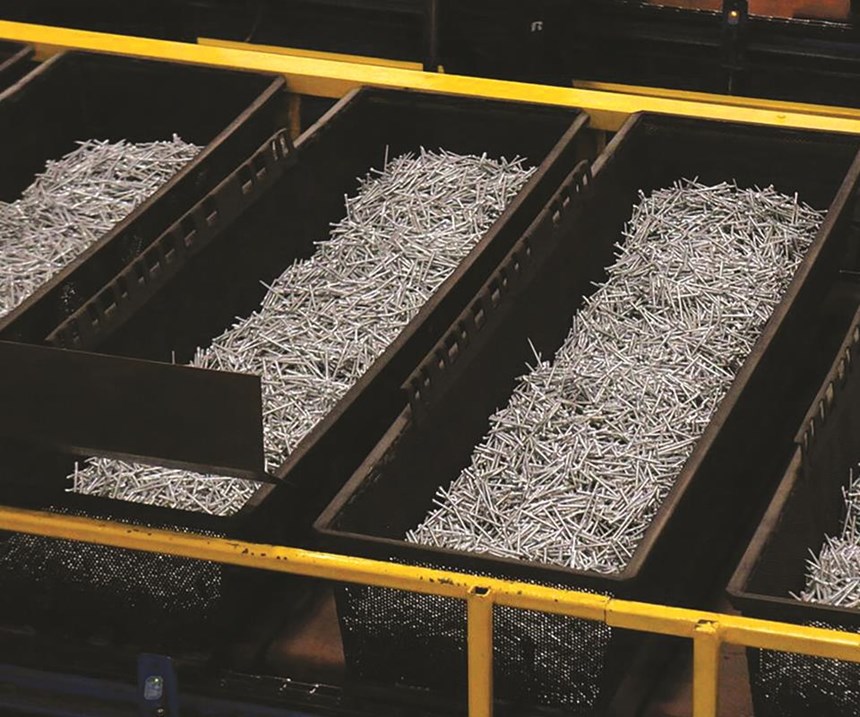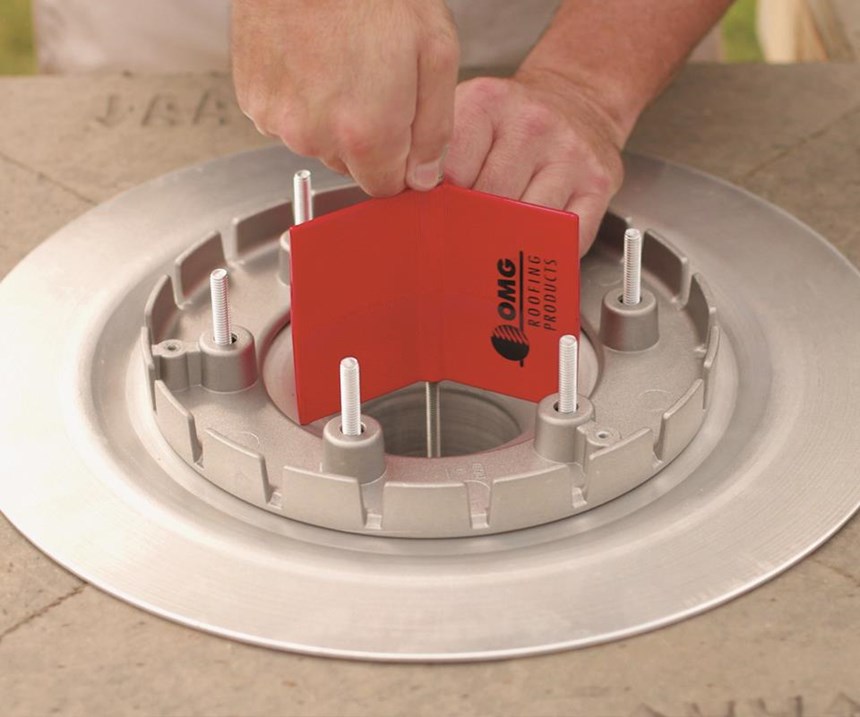Pretreatment Change Eases Wastewater Headaches
OMG Roofing Products gets help with wastewater treatment.
OMG Roofing Products in Agawam, Massachusetts, has become a giant in the fastening business since its founding in 1981, manufacturing more than 325,000 pounds per week of roofing and deck fasteners.
Operating three shifts, five days a week, OMG turns out a minimum of 60,000 pounds of screws daily. Contractors and do-it-yourselfers can find its Fasten-Master brand in big-box home improvement stores nationwide.
Not surprisingly, the philosophy of such a market leader is one of continuous improvement, particularly after a case of negative consequences occurring with the company’s wastewater stream.
When the company switched to a new pretreatment system on its paint line—an acid-pickle bath—the result was far too much zinc in its wastewater effluent. OMG was forced to change its wastewater chemistry and called on chemical supplier Hubbard-Hall Inc. for help, due in large part to the supplier's reputation for being “on call.”
Reducing the amount of zinc in the wastewater included a lot of house calls from Hubbard-Hall, with the comprehensive tank-side support for which the company is known, and a fair amount of Red Bull energy drink.
Out of Compliance
David Joyce, Hubbard-Hall’s technical service representative, led a team of wastewater treatment experts in developing a recipe that included AquaPure 100, a custom-blended inorganic coagulant, as well as AquaPure P601 metal precipitant and AquaPure FW polymer flocculant in liquid form.
“The zinc was in and out of compliance due to the citric acid pickling, which is a chelator of metals,” Joyce says. “The system had appropriate equipment to handle the stream, which indicated a chemistry change should suffice.”
While AquaPure is the name of the chemistry, Joyce says it also refers to a process that includes on-site visits, which Hubbard-Hall likes to refer to as “house calls.” During such a visit, an AquaPure technician arrives on site to evaluate the health of the wastewater system with a goal of optimizing it, providing process improvement recommendations and the required training for the facility operators.
The evaluation process usually consists of a diagnosis of the system, starting with a project outline meeting in which a Hubbard-Hall technician discusses the current state of the wastewater system and reviews any potential process improvements. These improvements could include reducing waste, costs and energy usage, and eliminating discharge issues. A physical examination follows to assess equipment setup and ensure type and suitability of the wastewater treatment product.
Jar Testing
The next step is laboratory testing, including jar testing, also known as bench testing, where the technician tests the wastewater on site or alternatively in Hubbard-Hall labs. Finally, the examiner makes a prognosis, setting process recommendations and implementations, including a detailed process improvement report, cost analysis, templates to track wastewater treatment data, and staff training on new processes such as correct dosing and testing procedures.
During OMG’s house call, Joyce and his team met with the company’s senior management to discuss findings and recommendations. Once these recommendations were accepted, an improvement plan was initiated.
“The changes had to go slow as to not overwhelm them and prioritize by necessity,” Joyce says. “It started with equipment to stabilize the system and aid in compliance. We then followed with employee training.”
AquaPure P601 is a ditmethyl dithiocarbamate-based liquid precipitant for removal of heavy metals and contains no polymeric coagulants. Applied at a pH of 7-12 to break complexing, it is fast-acting and produces minimal sludge. Metal reduction ranges to less than 1.0 ppm.
“It is a workhorse metal precipitant,” Joyce says. “It also works well on copper and nickel dissolved metals. It’s essential for use on chelated solution treatment.”
AquaPure FW is an anionic, high-charge, liquid polymer for wastewater treatment that will neutralize cationic charges to precipitated matter, allowing it to settle rapidly. It can be used in batch or continuous-settling lamella-type tanks. Joyce also says many applications can use Aquapure FW after pH adjustment only, but a cationic coagulant might also be necessary.
Degradation in Clarity
Early returns on the adjustments at OMG were positive, however, degradation in clarity was occurring between the first and third shift at the shop. That was when Red Bull was added to the recipe.
“Being there, there’s nothing like it to actually get to the bottom of things,” Joyce says, “I bought a six-pack of Red Bull and pulled a 16-hour shift. Nobody went near that clarifier except me. It ran crystal-clear that day.”
Ultimately, consistency came to the wastestream in the form of jar testing, a protocol Hubbard-Hall recommended but OMG had never followed before.
“We never knew how to do jar testing,” Mark Hortie, OMG’s electrocoat process supervisor says. “The daily checks it provides give us an idea of what’s coming at us.”
In fact, Hortie liked the idea so much that it has now become a requirement of all operators on every shift to do jar testing, documenting waste generation and chemical changes in log books created by Joyce and his team.
Bottom line: Hubbard-Hall helped OMG reduce the level of contaminants, principally zinc, from 2.3 to 0.23 ppm, well below the regulated requirements of city and state agencies.
“Having them onboard is like having a doctor always available to make a house call,” Hortie says.
For more information, visit hubbardhall.com or call 866-441-5831.
Originally published in the February 2017 issue.
Related Content
NASF/AESF Foundation Research Project #120: Electrochemical Destruction of Perfluorooctanesulfonate in Electroplating Wastewaters - April 2022-March 2023
This NASF-AESF Foundation research project report covers project work from April 2022 to March 2023 at the University of Illinois at Chicago. The overall objective of this work is to utilize a cost-effective reactive electrochemical membrane (REM) for the removal of PFAS from synthetic electroplating wastewater. Initial results for the oxidation of PFOA with three different catalysts are discussed.
Read MoreTop 5 Areas to Consider Automation of Plating Operations
Automation for finishing operations can lead to improvements in process time, repeatability and consistency of quality. Yet, processes that make sense to explore for these operational efficiencies may not always be readily apparent.
Read MoreHubbard-Hall Acquires BioConversion Technology
The acquisition adds experience and biologics to the AquaPure product line.
Read MoreNASF/AESF Foundation Research Project #122: Electrochemical Approaches to Treatment of PFAS in Plating Wastewater - 9th Quarterly Report
The NASF-AESF Foundation Research Board selected a project addressing the problem of PFAS and related chemicals in plating wastewater streams. This report covers the ninth quarter of work (January-March 2023). In this report, we describe our work on evaluating the performance of PFAS degradation by electrooxidation using surface fluorinated Ti4O7 anodes in batch mode.
Read MoreRead Next
Delivering Increased Benefits to Greenhouse Films
Baystar's Borstar technology is helping customers deliver better, more reliable production methods to greenhouse agriculture.
Read MoreA ‘Clean’ Agenda Offers Unique Presentations in Chicago
The 2024 Parts Cleaning Conference, co-located with the International Manufacturing Technology Show, includes presentations by several speakers who are new to the conference and topics that have not been covered in past editions of this event.
Read MoreEpisode 45: An Interview with Chandler Mancuso, MacDermid Envio Solutions
Chandler Mancuso, technical director with MacDermid Envio discusses updating your wastewater treatment system and implementing materials recycling solutions to increase efficiencies, control costs and reduce environmental impact.
Read More
























